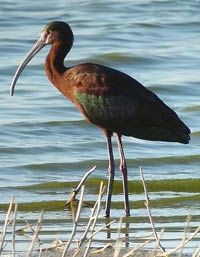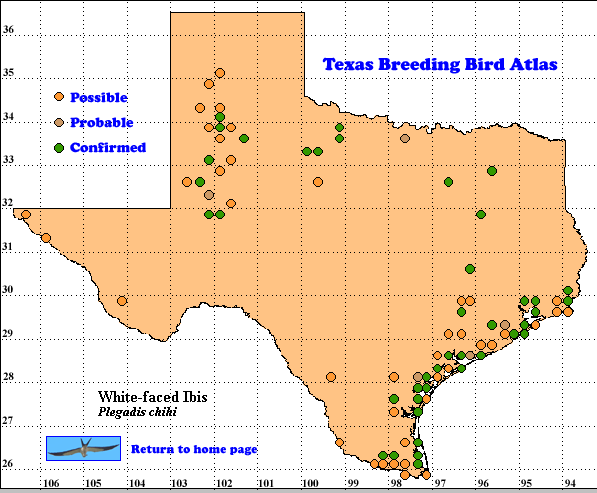There is close association of White-faced Ibises with Texas rice fields where they are exposed to insecticides. During the early 1970s, their reproductive success was limited by DDE-induced egg shell thinning and by dieldrin (aldrin) where high concentrations in brain and other tissues were linked to extensive mortality of nestlings and juveniles (Flickinger and Meeker 1972, King et al. 1980). Since 1974, these ibises have recovered slightly and some have established inland breeding colonies.
In Texas, an important influence on waterbird populations is the 20-25 year precipitation cycle (Telfair 2002). Between the early 1960s and late 1980s, there was a significant upward trend in the cycle; since then, the trend has begun to decrease (Tom Spencer, Texas Forest Service, pers. comm.). The trend varies regionally and there are intermittent drought years and irregular intervals with pronounced wet/dry springs-summers such as those associated with El Niño/La Niña years and massive slow-moving atmospheric disturbances (Dr. Robert K. Peters, NWS Observer for Tyler, Texas, pers. comm.). Inland wetland habitats are particularly subject to the effects of these trends. Unfortunately, various census techniques were used between 1959-1973 and the data collected during those years are not readily comparable and are not comprehen- sive. Thus, the possible relationship between White-faced Ibis breeding populations and the precipitation cycle are unknown for earlier years.
White-faced Ibises are dark-colored, thus difficult to detect; and they are highly mobile and tend to shift breeding areas from year to year. Hence, population censusing is especially important (Ryder and Manry 1994).
DISTRIBUTION: The White-faced Ibis is an uncommon to common resident along the Texas coast; and, is a rare and localized breeder inland as far north as the Panhandle (Lockwood and Freeman 2004). They inhabit primarily freshwater wetlands, especially cattail (Typha spp.) and bulrush (Scirpusspp.) marshes, although they feed in flooded hay meadows, agricultural fields, and estuarine wetlands (Ryder and Manry 1994). Oberholser (1974) reported that White-faced Ibises once bred inland in Texas (Hidalgo County 1877, Bee County 1904, McLennan County 1900, and Bexar County 1916); but, had become confined to near-coast colonies. Since 1959, they have expanded their breeding range inland to include scattered locations in the eastern, central, and north-central regions (Waller in Waller County 1959-1961 (no census), LaGrange in Fayette County 1976 (24 pairs), Ennis in Ellis County 1975 (2 pairs), Carlos in Grimes County 1988 (1 pair), Southside Water Treatment Plant in Dallas County 1990 (1 pair; Telfair 1980, Mullins et al. 1982, Peterson 1991). New breeding sites have also been found in the Panhandle and South Plains regions, e.g., in Hansford and Armstrong counties 1997 and three previous records in the Panhandle prior to 1997 (no locations or censuses given) and at Buffalo Lake in Randall County 1999 (20 pairs: Lasley et al. 1997, Lasley et al. 1999, TBBA).Based upon Texas colonial waterbird censuses (1973-1990), most of the breeding population is coastal (99.5-99.9%); but, occasionally, 0.04-0.45% breed inland.
SEASONAL OCCURRENCE: White-faced Ibises breed from early April–late July with eggs found from April 20-July 2 and half-grown chicks on May15, two-thirds grown chicks June 30 (Oberholser 1974).This species is resident along the coast with population increases along the Coastal Prairies as wintering migrants arrive. Individuals occasionally linger inland throughout the winter as far west as the Trans-Pecos region, but these ibises are not recorded from the Panhandle or South Plains past November. They are uncommon to common migrants in most regions of the state (Lockwood and Freeman 2004).
BREEDING HABITAT: The White-faced Ibis nests in small to large colonies often in association with other species of colonial waterbirds. Colonies are primarily on islands along the central and upper coast. However, these ibises nest occasionally in inland marshes and swamps. Where they nest inland, nests are located mainly in shallow marshes with “islands” of emergent vegetation (Ryder and Manry 1994). Some colony sites are used repeatedly over several years. Large colonies are composed of highly synchronized subcolonies that are spatially and temporally discrete. Nests are usually placed in emergent vegetation or shrubs and low trees over shallow water. Sometimes nests are placed on the ground on islands among low shrubs and mixed forbs. At such locations these ibises presumably avoid terrestrial predators (Ryder and Manry 1994). Nest heights range from floating on the water surface to 30 cm (1 ft) above water in emergent vegetation (Bent 1926). Ryder (1967) described Texas and Louisiana colonies in coastal marshes. In 1974, a dry land colony was studied on Danger Island, Aransas Pass, Texas and may have been a recent habitat change (Berger and Miller 1977).
STATUS: According to Texas colonial waterbird censuses (1973-2000), the annual breeding population fluctuates widely between about 350-6,500 pairs (McFarlane 2002). He also analyzed Texas colonial waterbird census data between 1973-2000. He foundthe breeding population of the White-faced Ibis had a highly significant annual decreasing trend of -5.1% with the typical pattern of annual fluctuations, but with lesser fluctuations in the latter half of the trend period. Nevertheless, within this time span, there were years with high census numbers; so, the decline may be related to regional responses to the precipitation cycle (see Introduction and Distribution discussions above). North American Breeding Bird Survey data for Texas (Sauer et al. 2005) give annual trends of -15.4% (1966-1979), -2.4% (1980-2005), and 6.0% (1966-2005); thus, indicating an overall increasing trend in contrast to the decreasing trend shown by colonial waterbird census data.
Text by Raymond C. Telfair II (2007)
Literature cited.
Bent, A. C. 1926. Life histories of North American marsh birds. U.S. Natl. Mus. Bull. 135.
Burger, J. and L. M. Miller. 1977. Colony and nest site selection in White-faced and Glossy Ibises. Auk 94: 664-676.
Flickinger, E. L. and D. L. Meeker. 1972. Pesticide mortality of young White-faced Ibis in Texas. Bull. Environ. Contam. Toxicol. 8: 165-168.
King, K. A., D. L. Meeker, and D. M. Swineford. 1980. White-faced Ibis populations and pollutants in Texas, 1969-1976. Southwest. Nat. 25: 225-239.
Lasley, G. W., C. Sexton, M. Lockwood, and W. Sekula. 1997. Texas region (nesting season). Field Notes 51: 1018-1023.
Lasley, G. W., C. Sexton, M. Lockwood, W. Sekula, and C. Shackelford. 1999. Texas region (nesting season). N. Am. Bird 53: 408-411.
Lockwood, M. W. and B. Freeman. 2004. The TOS handbook of Texas birds. Texas A&M. University Press, College Station.
McFarlane, R. W. 2002. Texas colonial waterbird trends (Powerpoint presentation). http://www.fws.gov/texascoastalprogram/TCWC.htm.
Mullins, L. M., G. W. Blacklock, D. R. Blankinship, A. H. Chaney, S. Kennedy, K. A. King, R. T. Paul, R. D. Slack, J. C. Smith, and R. C. Telfair II. 1982. An atlas and census of Texas colonial waterbird colonies 1973-1980. Texas Colonial Waterbird Soc., Caesar Kleberg Wildl. Res. Inst.., Texas A&I University, Kingsville.
Oberholser, H. C. 1974. The bird life of Texas. University of Texas Press, Austin.
Peterson, J. J. 1991. City of Dallas water treatment plant produces three unusual north central Texas nest records. Bull. Texas Ornithol. Soc 24: 25-27.
Ryder, R. A. 1967. Distribution, migration, and mortality of the White-faced Ibis (Plegadis chihi) in North America. Bird-Banding 38: 257-277.
Ryder, R. A. and D. E. Manry. 1994. White-faced Ibis (Plegadis chihi). In The Birds of North America, No. 130 (A. Poole and F. Gill, eds.). The Birds of North America, Inc., Philadelphia, PA.
Sauer, J. R., J. E. Hines, and J. Fallon. 2005. The North American Breeding Bird Survey, results/analysis 1966-2005. Version 6.2.2006. USGS Patuxent Wildl. Res. Cnt., Laurel, Maryland. http://www.mbr-pwr.usgs.gov/bbs/bbs.html.
Telfair, R. C. II. 1980. Additional inland nesting records in Texas of four species of colonial waterbirds. Bull. Texas Ornithol. Soc. 13: 11-13.
Telfair, R. C. II. 2002. Inland heronries in Texas. Texas Partners in Flight Newsletter, Texas Parks and Wildl. Dept. 9: 20.

